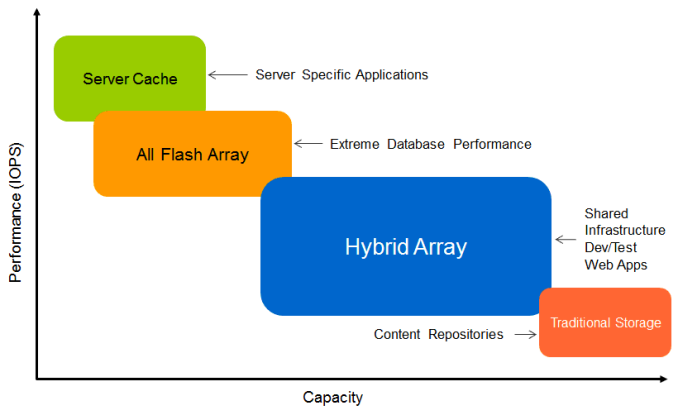The Impact of Disruptive Technologies on the Professional Storage Market
by Johan De Gelas on August 5, 2013 9:00 AM EST- Posted in
- IT Computing
- SSDs
- Enterprise
- Enterprise SSDs
Conclusions
The storage market is finally waking up from its long hibernation. After years of high prices for underperforming SAN storage systems, Fusion-IO is challenging the storage giants with products that are engineered to take MLC flash to its full potential. The result is that even relatively cheap storage systems can deliver higher IOPs than the fastest SANs of the traditional SAN vendors.
NetApp did not fall asleep though: it integrated flash everywhere they could. If your budget is limited, you will not be very enthusiastic as the flash acceleration comes with a huge premium. If you are running expensive software and are already a NetApp customer, however, these new innovations are probably the only way to offer excellent response times. As you can reduce the spindle count, the price per TB and performance per dollar get a lot better.
But the age of the storage OS of the traditional SAN vendors is showing: adding flash everywhere and updating the OS is not as efficient as engineering a product from the ground up to make the most of flash. It is clear that NetApp and EMC have the best solutions for the traditional storage market, but they are facing heavy competition in the much faster growing "Hybrid Array" and "All Flash Array" markets. And many customer are looking beyond the traditional SANs.
Nutanix has lured away lots of customers who wanted something less complex to run VDI. CloudFounders has and will make heads turn as those with large amounts of data cannot ignore the fact that the current RAID algorithms cannot cope with tens of terrabytes very well, let alone Petabytes. The Bitspread technology of Amplidata allowed CloudFounders to build a storage system that comes with an unseen flexibility and availability. The current SAN vendors can only match this with their most expensive clusters and storage gateways, while CloudFounders uses very inexpensive Supermicro servers and SATA disks.
The storage market is changing, and those who ignore the winds of change will have to spend a lot of cash only to end up with fewer IOPs.











60 Comments
View All Comments
prime2515103 - Wednesday, August 7, 2013 - link
I know, it just seems unprofessional. It's a tech article, not a chat room.FunBunny2 - Tuesday, August 6, 2013 - link
What is always missing from such essays (and this one reads more like a 'Seeking Alpha' pump piece) is a discussion of datastore structure. If you want speed and fewer bytes and your data isn't just videos, then an industrial strength RDBMS with a Organic Normal Form™ schema gets rid of the duplicate bytes. Too bad.DukeN - Tuesday, August 6, 2013 - link
But has there actually been any disruptions to the top dogs?EMC, NetApp, storage from HP/Dell/IBM, Hitachi all have had significant earnings increases yet again.
So maybe a couple of new startups as well as FusionIO are making money now, but some of the big guys can probably just buy them out and shelf them.
davegraham - Tuesday, August 6, 2013 - link
Look at EMC's acquisition of XtremeI/O...that's a viable competitor that EMC has already been able to integrate as a mainstream product. Oh, and they're also using Virident PCIe cards for server-side flash. ;)DukeN - Wednesday, August 7, 2013 - link
But is that really disruptive, or business as usual? These guys usually buy up smaller technologies as needed and integrate them if needed. Most of their core business (spinning disks) has remained the same.bitpushr - Friday, August 9, 2013 - link
XtremIO is still not a shipping product. It is not generally-available. So, I do not think this qualifies as "integrate as a mainstream product".Likewise their server-side Flash sales (Project Lightning) have been extremely slow.
phoenix_rizzen - Tuesday, August 6, 2013 - link
If you ditch Windows on the desktop, you can do a lot more for a lot less.$22,000 for a Nutanix node to support a handful of virtual desktops? And you still need the VDI client systems on top of that? Pffft, for $3000 CDN we can support 200-odd diskless Linux workstations (diskless meaning they boot off the network, mount all their filesystems via NFS, and run all programs on the local system using local CPU, local RAM, local GPU, local sound, etc). The individual desktops are all under $200 (AMD Athlon-II X3 and X4, 2 GB of RAM, onboard everything; CPU fan is the only moving part) and treated like appliances (when one has issues, just swap it out for a spare).
No licensing fees for the OS, no licensing fees for 90+% of the software in use, no exorbitant markup on the hardware. And all staff and students are happy with the system. We've been running this setup in the local school district for just shy of 10 years now. Beats any thin-client/VDI setup, that's for sure.
turb0chrg - Tuesday, August 6, 2013 - link
Another vendor doing hybrid storage is Nimble Storage (http://www.nimblestorage.com/). I've looked at their solution and it is quite impressive. It's not cheap though.They also claim to be the fastest growing storage vendor!
dilidolo - Tuesday, August 6, 2013 - link
I have 2 of them for VDI, they work fine, but I wouldn't call it enterprise storage.equals42 - Saturday, August 17, 2013 - link
It's only iSCSI so you better like that protocol.